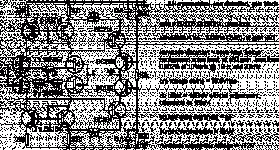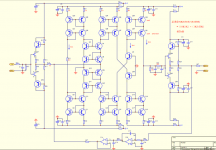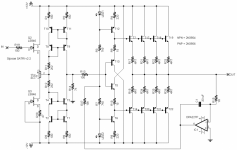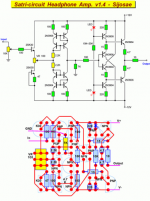No body makes better mirrors then you and i even do not know how you make them
Thanks
Anyway, I think you should use the "Gerhard" mirror?
With some small modifications it will be a very nice current mirror.
Stein
Attachments
A second helper transistor and differential feedback. I use it in two stage RIAAs where i can afford a lower output impedance. It lowers DC offset and distortion in that case. I did not try it in AIOG RIAAs so far because i was afraid that the output impedance gets too low.
The components in the transimpedance RIAA have then to be adjusted or we end up with a bass loss. Maybe you have an idea. I know that you are an expert on mirrors but actually i have never seen a circuit diagram you made.
The components in the transimpedance RIAA have then to be adjusted or we end up with a bass loss. Maybe you have an idea. I know that you are an expert on mirrors but actually i have never seen a circuit diagram you made.
Stein, i do not exactly know what you have in mind and i am not in design mood tonight but one way would be to move the differential feedback up one story to maintain a relatively high output impedance. The other way that comes to mind is to use a real cacode as output.
Attachments
The output resistance has to be known over certain frequency range. If the mirror has a finite output resistance and an upper frequency limit it can be taken care of by adjusting the RIAA values. Most trouble happens in the deeper bass regions anyway.Even a simple Widlar mirror is extremely wide band and has enough output resistance to give enough gain. What i do here is totally over the top anyway. I got even criticized by some that i do not respect Orcams rasor so my circuits can not sound good because they are over complicated. I can make perfect mirrors but this does not belong here. Stein has a variety of the mirror i use but somehow he is refusing to publish it. I respect that.
Calvin pointed out in the Euvl I / U converter tread that the Starless and Bible black stage needs a separate supply for the buffer or the output current is limited to the current that goes into the first stage. That will bring some additional complication. On the other hand i can imagine that i conventional supply feeding the input stage and the buffer could work too.
This is where a am right now....I have made a PCB..And will start to assemble when I have the last components here....It's basically an elaboration on Nico's take on Lazycats circuit...Show's some promise I think..
Interesting circuit, looks to me like the JLH pre circuit but with cascoded inputs and a ouputstage. I think Ive seen it before in a rega amp, not sure now but I remember the basis of the Rega circuit was also the JLH pre circuit. Should be a good performer.
Biaing of Q4, Q5 can be done simpler but it is ok. The transistors cost virtually nothing.
By why do they add a criss crossed second current mirror ? To raise output impedance ?
Anyway, thanks for sending me that circuit. I have never seen a full Satri before except a rather simple Head Phone amp from Korea.
By why do they add a criss crossed second current mirror ? To raise output impedance ?
Anyway, thanks for sending me that circuit. I have never seen a full Satri before except a rather simple Head Phone amp from Korea.
Last edited:
Nothing like the complicated Satri circuit from japan
I consider this a masterpiece of bull**** electronics.
Note: more similar stages can easily be added for
further complication. Would be my preferred way
if I had a semiconductor plant.
Last edited:
The helper transistors ease matching of Hfe because they compensate the base current.
The differential feedback resistors should lower DC offset and distortion. I have not tried it in this position. See a circuit i posted on your thread where they are in the usual position.
For an I/V converter this should work well because only a rather low value resistor is needed for the desired gain at the output to ground. For an AIOG RIAA stage i need more output impedance so putting the differential feedback resistors parallel to the mirror network screws up the desired frequency curve ( RIAA ) with the high value parts i choose.. I could try a compromise. Say 100kOhm differential feedback resistors plus lower value RIAA components. The output impedance of the fed back mirror could then be assumed to be to 50kHz but maybe i am wrong here. The disadvantage of that arrangement would be that the circuit has to throw considerable current around and that lowers dynamic range i think. To put the resistors " one story up " is my attempt to end up with a use full high output impedance and still get some benefit from the feedback. There are many other mirrors possible, for example the mirror with cascode that is NOT the same as a cascode current mirror.
The differential feedback resistors should lower DC offset and distortion. I have not tried it in this position. See a circuit i posted on your thread where they are in the usual position.
For an I/V converter this should work well because only a rather low value resistor is needed for the desired gain at the output to ground. For an AIOG RIAA stage i need more output impedance so putting the differential feedback resistors parallel to the mirror network screws up the desired frequency curve ( RIAA ) with the high value parts i choose.. I could try a compromise. Say 100kOhm differential feedback resistors plus lower value RIAA components. The output impedance of the fed back mirror could then be assumed to be to 50kHz but maybe i am wrong here. The disadvantage of that arrangement would be that the circuit has to throw considerable current around and that lowers dynamic range i think. To put the resistors " one story up " is my attempt to end up with a use full high output impedance and still get some benefit from the feedback. There are many other mirrors possible, for example the mirror with cascode that is NOT the same as a cascode current mirror.
I designed a tone control. Basically it is a low noise version of the JLH-Baxandall with one of my buffers at the input plus a volume control ( can be left out ).
The interesting thing is that you can set it up to mimic the RIAA curve quite closely so putting the switches and potentiometers in the right position you need only a linear amplification stage with enough gain and you have an unusual phono stage. The controls can mimmic other curves too so you can make recordings that are not cut with the RIAA curve digestible. Putting a phono stage with RIAA included in front of it you can use the controls more supple for the same result. You can use it of cause in the original intent to EQ flaws in the recording, lower hiss or ruble or have some control over the speaker-room interface.
The interesting thing is that you can set it up to mimic the RIAA curve quite closely so putting the switches and potentiometers in the right position you need only a linear amplification stage with enough gain and you have an unusual phono stage. The controls can mimmic other curves too so you can make recordings that are not cut with the RIAA curve digestible. Putting a phono stage with RIAA included in front of it you can use the controls more supple for the same result. You can use it of cause in the original intent to EQ flaws in the recording, lower hiss or ruble or have some control over the speaker-room interface.



